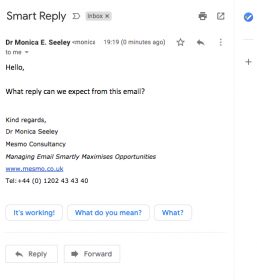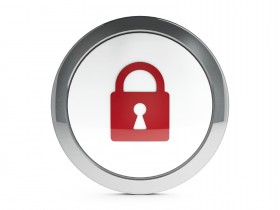Top tips from Mesmo Consultancy (and Associates) on how to save time and improve business and personal performance by ‘Taking Control of your Inbox’ and using proper business email etiquette.
After writing about business email overload for the past decade, it still amazes me to hear executives complain about receiving over 70 emails a day but still having done nothing to identify why and what can be done to reduce email overload. This includes the whole spectrum of employees from CEOs to PAs.
Should I be surprised? After all many have suggested that email is nearing the end of its life and will be overtaken by collaborative tools and social media. Yet the data from Radicati suggests otherwise with email volumes set to rise by 4% in 2019.
Business email overload is generally a symptom of a wider personal, team or organisational failing. For example, lack of ability to focus on the task in hand, prioritise, insufficient opportunities to talk to one’s boss so instead we email, a need to cover one’s backside, no clear e-communications guidelines as to what to use when and so it goes on.
These are some of the more common underlying causes of business email overload which I have observed over the last decade. There are several easy ways to reduce the time spent dealing with unnecessary emails and these include:
As I take over the Social Media Chair for IORG for November (from my colleague Alfonso Aranda Arias), these are some of the issues I will address in a series of Blogs and Tweets.
Tags: Business email overload, email overload, IORG, Radicati Group

Google Smart Reply
Will Google Smart Reply function help us save time or waste time as it drives up email overload? Anything which can help us save time dealing with email surely has to be welcome. The idea of being presented with three possible templates of text to use to reply to an email is very appealing. It is useful when replying from a mobile device as it avoids typing mistakes and saves you time crafting your own reply.
However, either hit the wrong one and an email might ping back at you as the recipient does not understand what you mean. Or they might misinterpret your response. After all ‘Thanks’ can have many meanings from genuine gratitude to ‘so you just dumped me in it’. Result, increased email overload as we play endless rounds on unnecessary email ping-pong.
When we run Smart Email Management workshops one constant request is to educate participants to write short simple emails (responses) which portray a professional image of themselves and their organisation and communicate unambiguously what they are saying.
Why does this need exist for good email etiquette? After all most employees have had a good education and should have a basic command of the English language. Perhaps because the majority of today’s younger generation are so grounded in text speak that they quickly forget the basics of good grammar and spelling. Therefore will Smart Reply help? Or will it just exacerbate the situation?
Then there is GDPR. Forget email overload. An email is forever despite the fact you deleted the reply you sent in haste and now regret. Smart Reply might just offer lawyers a field day.
Templates of text are a great way to save time and especially when you need to reply to a stack of emails with the same response for example acknowledge an invite, receipt of a CV, invoice, revise project plan etc. And maybe, just maybe the old fashioned way of either cutting and pasting from a pre-prepared template of text is still the best option (in Word, Google Docs etc). For Outlook users you can use Quick Parts to create such templates.
This is the best way to reduce email overload and improve business email etiquette and hence performance.
Tags: email etiquette, email overload, GDPR, Google Smart Reply, Outlook - Quick Parts
Most of us suffer from chronic business email overload. The new 2018 Adobe Email Research revealed that the most irritating email phrases include:
There is little doubt that these are words which make the blood pressure rise and can destroy good relationships. The question is why does it happen?
Mesmo Consultancy’s research indicates that we receive roughly one new email every five to seven minutes of which over 50% are deemed unnecessary by the receiver. After a one hour meeting about 12 new emails are now on top of the existing backlog. If like many you spend at least two hours a day in meetings that’s 24 new emails added to the already bulging inbox. Little wonder business email overload is a cause of high blood pressure and sleepless nights. It’s not uncommon to see 500+ unread emails in the inbox.
Whose fault is it that emails are not answered and what can be done to reduce the need for these highly irritating email follow-up? Does every email sent add business value or instead flatter the sender’s personal ego? Are we so disorganised and have such a high degree of email overload that it’s impossible to see the wood from the trees?
Sender’s perspective
There are a number of reasons why your email has may have been overlooked. Many related to common sense business email etiquette. Here are the top five we see most often and tips to overcome them to save time to reduce business email overload and hence improve business performance.
1. Email is too long. You are time poor and wrote the sentences as they came into your head. You didn’t have to re-read and revise it.
Tip #1 – Use the 5S Principle of Business Email Etiquette for writing good emails – keep it structured, short, succinct, spell-checked and simple formatting. If appropriate start with a one line executive summary.
2. No clear indication of what action is expected. Did you use the correct protocol for To and Cc and make it clear in the subject-line if any action is expected and by when?
Tip #2 – Always put the recipient in the To box if you expect action. Use the subject-line to be explicit if there is a deadline for action.
3. Sent well outside normal office hours. Now it is buried in the pile of other unread emails .
Tip #3 – Draft outside office hours but only send within normal office hours.
4. Wrong medium for the message. Oh dear we are so addicted to email that we forget there are other ways to communicate and especially if the message is urgent.
Tip #4 – Pick the right medium for your message, for example if it’s urgent phone/text message/walk and talk. Look outside the inbox for discussions, for example using a collaborative platform, conference call etc.
5. Love the sound of your own voice. In the days of silent open plan offices the easiest way to chat is by email. Some people just like to look busy by emailing.
Tip #5 – Take a look at your inner self and ask why you are sending the email, what purpose is it serving? To satisfy your own ego or add real business value?
Receiver’s perspective
Why did you ignore that email? Here are the top five reasons we see when coaching people to manage their email more efficiently
1. Email overload – too much email. You need to take control of what your receive and if needs be use filters to send less important emails directly to folders.
Tip #1 – Audit your inbox and reduce the number of emails you receive. Unsubscribe, use filters and remember it’s OK to say ‘No thank you’ to colleagues when included in a circulation list.
2. No adequate way to spot quickly emails from key contacts. With an average of 60 plus new emails a day, how do you spot those from important contacts and ensure they are dealt with?
Tip #2 – Implement a way of flagging/highlighting incoming emails from key contacts.
3. Email is too long and unclear what is expected. It really is not your fault if the sender rambles on, asks too many questions in one email etc.
Tip #3 – Push back. Don’t ignore the email hoping it will go away. Instead be bold and ask what is required and if needs be prioritise.
4. Too little time to check emails properly. We are all time poor and you need to prioritise your day.
Tip #4 – Make a meeting with yourself every day dedicated to dealing properly with your inbox instead of just surfing and skimming the content.
5. Easily distracted by new emails. You have a batch from yesterday, the meeting you have just attended and ping, you are distracted every five minutes as yet another new email arrives. Little wonder you probably have 500+ emails in your inbox.
Tip #5 – Turn off all those new email alerts. If needs be set one only for emails from the boss!
Whose Really At Fault
Over arching all these is the question of priorities and an organisational culture cover my backside culture. Given these different pressure points between the sender’s and the receiver’s perspective it is little wonder that emails go unanswered. Neither party is to blame, it is a combination of mismatches in personalities, styles and priorities. Hopefully these tips will help reduce the email overload caused by those annoying and irritating email follow-ups.
Can we Help You and Your Organisation?
For more ways to improve performance through more effective email management why not come on one of Mesmo Consultancy’s Smart Email Management masterclasses or workshop
Tags: 5S Principle of Business Email Etiquette, Adobe, business email etiquette, Business email overload, Business Performance, Irritating Emails, Mesmo Consultancy, Spell Check, To versus Cc, well being
Email overload will increase the risk of a breach of GDPR. Email overload and GDPR is like a red rage to a bull. Email management and compliance with GDPR starts at the individual user level. You can have all the organisational policies and technology infrastructures in place but if individuals are sloppy then there is a high and un-managed risk of breaching GDPR. It is not uncommon now for business executives and their PAs and EAs to be expected to handle over 100 emails per day. As business email overload continues to rage unabated so too the risk of making an error and sharing personal data by email which really should be kept private.
Whilst your organisation will have a GDPR policy and hopefully the relevant IT infrastructure, here are four ways every individual email user can help to improve compliance and protection of personal data.
How well are you training your staff about effective business email management and GDPR? Can you afford to pay up to 4% of turnover (or £17M) for breaching the new GDPR Act?
These are just four of at least ten ways you can mitigate the impact of email overload on GDPR
Call us now for more information about Mesmo Consultancy’s ‘Email Management and GDPR’ workshops and consultancy services.
Tags: Business email management, Business email overload, GDPR, Mesmo Consultancy
Email security remains a top priority for most IT Departments and especially as GDPR approaches. Here are five top ways to improving email security in your organisation and make sure you are not the one to open the door to the cyber-criminal.

Concerned about any of these points? Call us now to discuss how Mesmo Consultancy’s Smart Email Management masterclasses and workshops can help improve email security.
Tags: cyber crime, email security, GDPR, password protection, Word documents and malware